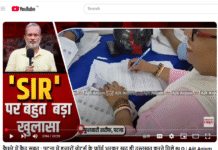After two days of informative and educational study tours, the two INMA seminars took place on 20 November 2019. The seminars were focused on the shift in patterns of content consumption and how to resolve the problem of depleting ad revenue in print.
Two sessions particularly – ‘Deep dive into the consumer ecosystem’ and ‘Spearheading change via advertising and technology’ – included interesting insights from leading tech and social media companies, who educated the audience on best practices to succeed in the digital space. Leading newspaper groups, on the other hand, shared their coping strategies in these disruptive times.
Hyperlocal campaigns for better engagement and recognition
HT Media uses local campaigns to improve brand imagery, reader acquisition and strong local affinity. Rajan Bhalla, chief marketing officer, HT Media, presented a case study on a 100-day campaign by HT Media – Revitalizing Meerut – where the Hindi daily, Hindustan, was perceived as an outsider and could not make it among the top circulating newspapers in the region. HT conducted paid surveys on more than 2 lakh households to find out the critical issues in the city. The research indicated that poor drainage system caused waterlogging, which directly led to traffic and illnesses.

Hindustan raised the issue by giving daily editorial coverage and print ads amplified with massive OOH campaigns to make the city dwellers aware of clogged drains and Hindustan’s initiative to resolve it. The newspaper also encouraged readers to contribute towards achieving results. The city administration took notice of the problem and mobilized its resources, which was covered by HT regularly. The campaign resulted in solving one of the most significant issues in Meerut and increased brand recognition for Hindustan.
Similarly, Basant Rathore, senior vice president – Strategy, Business Development, and Brand, Jagran Prakashan, presented how Jagran used campaigns to engage with hyper-local readers. The group created seven inspirational videos featuring 17 women who challenged gender stereotypes by taking up male-dominated jobs. The campaign resulted in increased brand engagement on social media, and the videos penetrated through a hyper-local audience. Jagran also invited 35 girls to its newsroom to create a unique newspaper for 11 October 2019 – the Internation Day of Girl Child. The group further appointed 62 girls as advisors to MPs, district magistrates and medical officers on 11 October and published the resulting stories in the next day’s daily. The 3 million copies of the resulting newspaper reached 17 million readers.
Harnessing the impact of social media
Tithi Sharma, News Partnerships India, Facebook, explained the audience how to leverage social media videos to engage with viewers and the different video formats available on Facebook for smartphones.
Amrita Tripathi, head – News Media Partnerships, Twitter, explained how newsrooms could leverage Twitter for storytelling. Her tips included using Hashtags and tweeting analysis during significant events such as elections, going live on Twitter to give live coverage as events unfold, and pinning live tweets for engaging followers. Creating threads for a story along with GIFs and photos, creating polls, and establishing an authentic voice also goes a long way to grab the attention of viewers, she said.

Mobile and video journalism for mobile-first users
Shitij Kumar Gupta, executive producer, NDTV 24 x 7, gave a presentation on NDTV’s shift from full crew and outside broadcast (OB) vans to a single smartphone and 3G backpack units for live broadcasts. Shifting to smartphones resulted in huge cost and resource savings for NDTV. He explained how the adaption of smartphones helped the news channel to launch its first-ever vertical digital channel, ideal for watching from a smartphone.

HT Media emphasized that before mobile-first screens and ad blockers were introduced, markets would create content for their platforms as well as host it on other platforms, but it was not visible to the audience. This changed three years ago when they learned to leverage social media for content distribution, and today content is created keeping in mind the consumer activity, discoverability, engagement and context. HT Media created a strategic content creator platform, HT Brand Studio Live, which had experiential value and supported cross-platform storytelling platform. The premium sponsored content targeting brands came from a mix of people with editorial, product, technology and marketing knowledge. To date, HT has created more than sponsored 1000 articles, 25 videos, 80 infographics and 15 specialty brand hubs for leading brands in the market, which is reported to have worked out well for the company.

Leveraging data for visibility
Neha Singh, director – Client Insight, Comscore, emphasized during her presentation that in India, news consumption is still high and is growing, although the formats will keep evolving. Partnerships are the cornerstone of news discovery and growth. Video journalism is increasing engagement and gaining traction. As internet access becomes more and more inclusive, vernacular news and content will continue to be consumed.
Ajay Menon, senior front end developer, Quintype, highlighted the benefits of levering smart data for content creation and increasing reach and reader engagement. Using data analytics and Google insights and commenting platforms and having a multi-channel distribution system can increase visibility on the web. Creating automated content will allow editors to work on rich content.

The seminars indicated that there is limited space for the traditional print model. Newspapers cannot rely on conventional ad strategies alone to survive. Adapting to the digital model, leveraging digital resources, market dominance and investment in technology could build the path to future success. The audience is no longer limited to one channel of information and news; so why should the ad revenue be?















